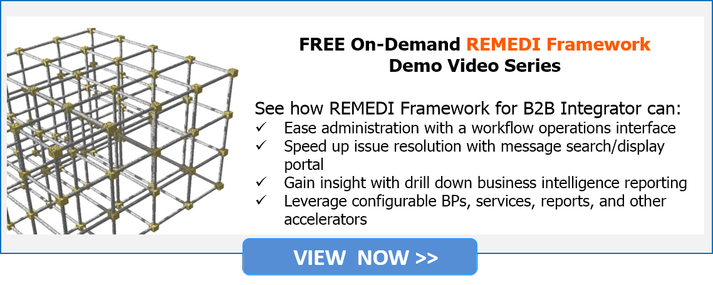Many articles are written with case building points and the hook at the end, we are going to take a different approach.
 B2B Gateways, or Comprehensive Integration Suites as they are known by in different circles, are incredibly powerful and flexible for all things integration and these "tool kits" can be incredibly complex. As a tool kit for integration, there is little integration architecture and predefined processes "laid down" at software installation time. Instead, the architecture is designed, planned, and built in a custom manner as part of the initial deployment. This custom integration infrastructure yields many advantages that will be outlined below, with the major disadvantages being extended deployment time and lack of built in functionality. The utilization of business process frameworks and software frameworks help combat these disadvantages and get you on the road to integration ROI quickly.
B2B Gateways, or Comprehensive Integration Suites as they are known by in different circles, are incredibly powerful and flexible for all things integration and these "tool kits" can be incredibly complex. As a tool kit for integration, there is little integration architecture and predefined processes "laid down" at software installation time. Instead, the architecture is designed, planned, and built in a custom manner as part of the initial deployment. This custom integration infrastructure yields many advantages that will be outlined below, with the major disadvantages being extended deployment time and lack of built in functionality. The utilization of business process frameworks and software frameworks help combat these disadvantages and get you on the road to integration ROI quickly.
Framework in a General Sense...
By the most basic of definitions a framework is a skeletal structure designed to support or enclose something a frame or structure composed of parts fitted and joined together the construction or sale of frames, or work done with a frame.
Framework from a Software Perspective...
A bit more applicable to the topic at hand is software framework, in the context of computer programming and systems development. Software frameworks, are pre-built purpose driven blocks of code that provide generic functionality and can be customized by changing/adding user-written code, thus providing custom application-specific software. A software framework is a universal, reusable software platform to develop applications, products and solutions.
Software frameworks allow software designers and programmers to devote their time to meeting software requirements rather than dealing with the low-level details of providing a working system, thereby reducing overall development time. Software frameworks have frozen spots and hot spots. Frozen spots define the overall architecture of a software system...basic components and the relationships between them. These remain unchanged in any solutions developed using the application framework. Hot spots represent those parts where the programmers using the framework add/change code to arrive at the functionality specific to their desired solution.
B2B Integration Gateways and the Framework Concept...
B2B Gateways integrate data from back-end systems and provide information exchange across trading partners and business systems. They also provide a centralized point for transformation of data from multiple data sources in a variety of formats...EDI, XML, proprietary, etc. The B2B Gateway software is typically developed using SOA architecture and techniques and integrates well with other systems developed and implemented using a similar methodology. By utilizing SOA concepts, B2B Gateways more easily possess other capabilities including trading partner management, security, control, mail boxing, communications and protocols. B2B Gateways help bridge the collaboration gap across supply chain partners and transform the data flow between companies from a batch oriented manner into a real time process. This directs and streamlines processing, monitoring for errors, exceptions, and event conditions which provide the enterprise with greater visibility and pro-active control over data and associated applications.
B2B Gateways provide flexible wide ranging functionality for integration, and as mentioned earlier, is more akin to an integration development toolkit than a plug and play purpose driven point solution for just EDI, system integration, or file transfer communications. Services, adapters (pre-build integrations to ERP, messaging, and communications products) and other components exist in this tool kit to support just about anything integration; data standards, communications protocols, web services, data transformation, etc., all within one solution. The power from a comprehensive integration gateway comes from the way integration building blocks can be strung together via business processes and configured to accomplish any integration task.
With so few processes and pre-configured integrations available out of the box there is a high degree of complexity as one begins implementing a B2B Gateway. And with complexity comes considerable implementation time. So, B2B Integration Gateway Frameworks have been developed based on the various Framework concepts above to combat complexity and extended implementation time.
B2B Integration Gateway Framework assets are libraries of pre-built, parameter-driven business processes, services, portals, reports, and other components configured in a manner in which re-usability is optimized and which extend the base functionality of B2B Gateways. The framework approach allows for asset (re)use in varying B2B Gateway deployments and speeds the implementation or upgrade process as well as provides flexible, scalable integration architecture. Through architecture and design sessions that define the desired infrastructure, these frameworks and associated assets leverage base integration patterns that commonly exist from installation to installation and are then custom configured and more quickly deployed in an organization's environment.
A framework approach is more valuable in B2B Gateways than in single purpose point solutions. Point solutions are purpose built integration tools for EDI or some other integration purpose like EAI, ETL, or for integration to/from a specific business system (e.g. ERP). In these solutions, standards and functionality are built in very rigidly for the specific purpose for which the solution was developed like data transformation, communications (internal network, VAN (specific or general), AS2, etc.), and so on. With most everything available to the purchaser out of the box (and no developer interface) software development experience is minimized and operation/administration is simplified. Point solutions are easy to learn and use, and are very good at doing the purpose driven things the tool was designed for. They are often unable to perform duties other than what they were designed for unless this functionality is provided for in pre/post processing software development. This extra development results in patchwork code to integrate previously unconnected systems and exposes extra break points requiring greater administration and skill requirements across the resulting systems. In contrast, all in one B2B Gateways with framework assets applied are multipurpose, are easily deployed, development toolkit based, possess fewer break points, and have a less broad skill requirement across various systems.
Interested in more information about B2B Integration Gateways & Framework?
Remedi Framework for IBM B2B Integrator
Remedi's IBM B2B Integrator Consulting & Deployment






